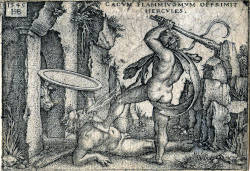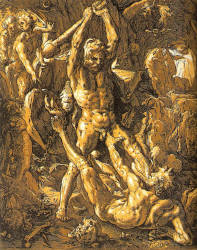Kakushöhle - Kartsteinhöhle
Kakus Cave - Kartstein Cave
Useful Information
| Location: |
Near Mechernich, Kreis Euskirchen.
A1 exit Nettersheim, turn right on 477, through Weyer to parking lot Café Zur Kakushöhle.
(50.544882, 6.659961) |
| Open: |
no restrictions. [2021] |
| Fee: |
free. [2021] |
| Classification: |
 Karst Cave Karst Cave
 Erosional Cave Erosional Cave
 Tufa Deposits Tufa Deposits
|
| Light: | bring torch |
| Dimension: | L=80 m, W=40 m, H=15 m. |
| Guided tours: | self guided |
| Photography: | allowed |
| Accessibility: | trail to cave is wheelchair accessible |
| Bibliography: |
Michael Baales (2001):
Kartstein bei Mechernich/Eifel
Ein naturkundlich-archäologischer Rundgang.
Hrsg.: Forschungsbereich Altsteinzeit des RGZM Mainz. Rheinland-Verlag, Schloß Monrepos, Mechernich, ISBN 3-7927-1844-8.
academia.edu
Sophie Lange (1995): Kakushöhle – Sagen von einst, Geschichten von heute, Mit einer Zeittafel. 1995. Hartwig Löhr (1978): Die Kartsteinhöhle gibt ihre Geheimnisse preis In: Kreis Euskirchen (Hrsg.): Jahrbuch des Kreises Euskirchen 1978. 1978, S. 20 ff. Alexander Sobotta (2006): Erlebnis Kartsteinfelsen – stufenlos in die Kakushöhle bei Mechernich-Dreimühlen In: Kreis Euskirchen (Hrsg.): Jahrbuch des Kreises Euskirchen 2006. 2006, S. 46 ff. |
| Address: |
Stadtverwaltung Mechernich, Bergstraße 1, 53887 Mechernich, Tel: +49-2443-49-0.
E-mail: Gabriele Schumacher, Team Bildung, Kultur und Tourismus, Fachbereich 3, Bildung, Soziales und Tourismus, Zi: 021, Tel: +49-2443-49-4322. E-mail: |
| As far as we know this information was accurate when it was published (see years in brackets), but may have changed since then. Please check rates and details directly with the companies in question if you need more recent info. |
|
History
| 1809 | designated "Roches caverneux" in the Tranchot map. |
| 1846 | designated as "CacusHöhle" in the topographical map of the Prussian original. |
| 1880 | Cave investigated by J. Ruhr. |
| 1900 | Examined by Prof. Fischer. |
| 05-AUG-1902 | visit by Crown Prince Wilhelm. |
| 1911 | Excavations under Carl Rademacher for the Cologne Anthropological Society. |
| 1913 | Excavations under Carl Rademacher for the Cologne Anthropological Society. |
| 1921 | Examination by H. Heck. |
| 1932 | Nature Reserve Kartsteinhöhlen with Kakus Cave designated. |
| 1939 | Excavations by L. F. Zotz into as yet unexamined layers of finds, finds were lost in the Second World War. |
| 1944/45 | Use as luftschutzbunker, as material storage of a factory and file storage of the district administration. |
| 1950 | inn rebuilt near the entrance to the cave. |
| 1959 | A. Herrenbrodt examines once again the cross-section from the excavation of L. F. Zotz. |
| 1970 | excavation near the east entrance of the large cave by H. Löhr. |
| 1977 | securing the cave ceiling by a reinforced concrete support beam, previous securing excavation by H. Löhr in the area of the foundations. |
| 1982 | pub burns down and may not be rebuilt. |
Description
The Kakushöhle (Kakus Cave) has been popular with tourists since the 19th century. Postcards with this motif were already distributed at the beginning of the century. The cave has paths and is therefore easy to walk through, the access path is even suitable for wheelchairs. The cave was named after the legend of the giant Kakus, who lived there for a time.


In ancient times, the giants Kakus and Herkules got into a bitter dispute. Pursued by Herkules, Kakus fled to the then nameless cave, which he inhabited for a time, and which was therefore named Kakus’ Cave. Eventually he was found by his opponent, defeated after a long fierce struggle and killed. But Herkules was also mortally wounded in this fight. He fled and made it as far as the vicinity of the village of Holzheim, where he succumbed to his wounds. A stone marking the spot where he died is therefore called Herkelstein.
This legend is quite old, but is an adaptation of a much older Roman legend in which originally demigod Hercules fights against a presumably Etrurian army commander Cacus and defeats him.
But already in Roman times the legend changed and the army commander became a giant, murderous robber who even knew how to breathe fire. He also decorated the gate of his cave dwelling on the slopes of the Aventine mountains with the skulls and bones of his victims. He was the son of Vulcanus and also had a sister named Caca. He messed with Hercules, who was driving the cattle of Geryon through Italy after his tenth deed, by stealing two (or four) of them. He was clever enough to drag the animals backwards into his den by their tails, so that the tracks pointed in the other direction. But the roar of a cow betrayed him. The gate was solid and impregnable, but Hercules tore off the roof of the cave, fought with Kakus and finally strangled him.
The cave is also known as Kartsteinhöhle (Cartstone Cave), why explains the following legend:
There were two farmers who preferred to play cards in the Kakushöhle during Holy Week rather than go to church. Then a stranger joined them and asked to play. The peasants agreed and the stranger lost a lot of gold to them. The stranger demanded revenge and suggested to both of them that the first one to finish the card game would be the devil’s guest forever. Blinded by the gold, the peasants agreed.
After a while, however, they realised that the stranger was the devil himself. They silently vowed, if they were saved, never to touch a card again and to honour Holy Week in the future. Neither of them dared to finish the game, however, and so they played for several days and nights.
Their wives missed the men and were looking for them. One of them finally found them and recognised the danger. She quickly notified the priest, who rushed to the cave and ordered the devil to release the two peasants. At the sight of the crucifix, the devil let go of the peasants, angrily tore up the rock and fled the cave through the resulting hole in the cave wall. This is how the narrow exit in the upper part of the large cave came about. However, the cave was named Kartstein after the card game.
The cave even has a third name, which again is explained by a legend.
Hellic, a Germanic goddess of the underworld, inhabits the cave, from which she mysteriously calls children into being. Naughty children are threatened with the Children’s Cave, where Hellic brings them back to chaos as punishment.
The Kakus Cave was excavated many times for a century from 1880. The most productive were the excavations in 1911 and 1913 under Carl Rademacher for the Cologne Anthropological Society. The finds were originally kept in the Museum of Pre- and Early History in Cologne, part of them was destroyed during the war, the rest is now in the Roman-Germanic Museum in Cologne. A further excavation by L. F. Zotz was able to examine layers of finds that had not yet been investigated. The published detailed report still exists, but the finds were also lost in the war. In addition, the cave was developed as an air raid shelter during the Second World War and therefore the cave floor was levelled in 1944/45, destroying most remaining deposits. The cave was used as a material store for a factory and a file store for the district administration. Nevertheless, excavation continued, and the finds are in the Rhineland Regional Museum in Bonn. The finds from a subsequent excavation in the overburden of the older excavations are in the Hürten Museum in Bad Münstereifel and the Eifel Museum in Blankenheim.
The various excavations yielded a micoque wedge, scrapers and points from humans. Faunal remains of giant deer, woolly rhinoceros, steppe bison, reindeer, wolf, musk ox, cave lion, horse, brown bear, cave bear, beaver, porcupine, marmot, mammoth, and hyena were discovered. The cave was visited by the Neanderthals between 70,000 and 30,000, around 12,000 by the reindeer hunters of the Ahrensburg culture. Both the cave and the plateau above it were used again and again from the Latenian period through the Roman period to the Middle Ages.
Tourist use began in the 19th century. At the end of the 19th century, an inn was built directly in front of the entrance. This was rebuilt after the war, but was not allowed to be rebuilt after it burnt down in 1982.
The Kakusfelsen (Kakus Rock) or Kartstein is a 150 m long and 60 m long limestone tuff block that was probably formed 300,000 years ago during an interglacial period by precipitation of limestone at a limestone-rich spring. The travertine is up to 18 m thick and the plateau on top is about 400 m asl. Such limestone tuff or travertine usually also has primary caves. It is assumed that the deposition of the travertine ended with the next cold period and the stream began to cut into the travertine until it reached the dolomite below. Unlike travertine, dolomite has fissures and allowed caves to form through karstification. In addition, it is friable, especially at the contact with the travertine, andis eroded relatively easily. Thus, the Kakus Cave, located in the underlying dolomite, is not a primary cave, and only to a small extent a karst cave, but primarily an erosion cave. At the same time, karstification occurred below and about 100,000 years ago, when the Kakus Cave and the valley had reached their present form, the valley became a dry valley and drainage today is underground. The water today rises down the valley at the north end of Eiserfey.
The main room of Kakus Cave is called Great Church and is 30 m wide and 15 m high. The adjoining room is called Dark Chamber. 50 m to the north is the small cave Kaltes Loch (Cold Hole).
- See also
 The Eifel Giant Kakus
The Eifel Giant Kakus Search DuckDuckGo for "Kakushöhle"
Search DuckDuckGo for "Kakushöhle" Google Earth Placemark
Google Earth Placemark Kakushöhle
Kakushöhle  - Wikipedia
- Wikipedia Kakus cave (visited: 03-APR-2021)
Kakus cave (visited: 03-APR-2021) Kakushöhle - Cave Entrances (Natural) on Waymarking.com (visited: 03-APR-2021)
Kakushöhle - Cave Entrances (Natural) on Waymarking.com (visited: 03-APR-2021) Limestone caves in Dreimuehlen, close to Mechernich (visited: 03-APR-2021)
Limestone caves in Dreimuehlen, close to Mechernich (visited: 03-APR-2021) Kartsteinfelsen und Kakushöhle
Kartsteinfelsen und Kakushöhle  (visited: 03-APR-2021)
(visited: 03-APR-2021)
 Index
Index Topics
Topics Hierarchical
Hierarchical Countries
Countries Maps
Maps